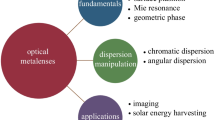Abstract
With increasing research interests in the field of light-matter interactions, various methods have been developed for regulating nonlinear optical (NLO) materials. However, the design and synthesis of organic molecular materials for second-order nonlinear optics remain a great challenge because of the strict requirement of the materials to possess a noncentrosymmetric structure. In this work, two benzothiadiazole (BTD) derivatives referred to as BTD-H and BTD-F were synthesized, and their NLO properties in the crystalline states were studied. It was found that introducing fluorine into the BTD backbone effectively tuned the crystal packing styles of BTD derivatives to a noncentrosymmetric system for effective second-order NLO responses. Such a strategy to induce the noncentrosymmetric structure by introducing the fluorine atoms and halogen interactions may provide guidance for future engineering of organic NLO molecular materials.










Similar content being viewed by others
References
Yu Balakina M, Nefediev SE (2006) Solvent effect on geometry and nonlinear optical response of conjugated organic molecules. Int J Quantum Chem 106(10):2245–2253
Blouin N, Michaud A, Leclerc M (2007) A low-bandgap poly(2,7-carbazole) derivative for use in high-performance solar cells. Adv Mater 19(17):2295–2300
Champagne B, Kirtman B (2001) Theoretical approach to the design of organic molecular and polymeric nonlinear optical materials. In: Nalwa HS (ed) Handbook of Advanced Electronic and Photonic Materials and Devices. Elsevier, Amsterdam, pp 63–126. https://doi.org/10.1016/b978-012513745-4/50073-1
Kelderman E, Starmans WAJ, van Duynhoven JPM et al (1994) Triphenylcarbinol derivatives as molecules for second-order nonlinear optics. Chem Mater 6(4):412–417
Torrent-Sucarrat M, Solà M, Duran M et al (2004) Basis set and electron correlation effects on initial convergence for vibrational nonlinear optical properties of conjugated organic molecules. J Chem Phys 120(14):6346–6355
Kato SI, Matsumoto T, Ishi-I T et al (2004) Strongly red-fluorescent novel donor–π-bridge–acceptor–π-bridge–donor (D–π–A–π–D) type 2, 1, 3-benzothiadiazoles with enhanced two-photon absorption cross-sections. Chem Commun 20:2342–2343
Loboda O, Zaleśny R, Avramopoulos A et al (2009) Linear and nonlinear optical properties of [60]fullerene derivatives. J Phys Chem A 113(6):1159–1170
Li M, Zhang H, Zhang Y et al (2016) Facile synthesis of benzothiadiazole-based chromophores for enhanced performance of second-order nonlinear optical materials. J Mater Chem C 4(38):9094–9102
Wang JL, Xiao Q, Pei J (2010) Benzothiadiazole-based d–π-a–π-D organic dyes with tunable band gap: synthesis and photophysical properties. Org Lett 12(18):4164–4167
Jiang D, Chen SH, Xue Z et al (2016) Donor–acceptor molecules based on benzothiadiazole: synthesis, X-ray crystal structures, linear and third-order nonlinear optical properties. Dye Pigment 125:100–105
Han X, Gong WX, Tong Y et al (2017) Synthesis and properties of benzothiadiazole-pyridine system: the modulation of optical feature. Dye Pigment 137:135–142
Gómez SL, Lenart VM, Turchiello RF et al (2016) Nonlinear optical properties of dye-doped E7 liquid crystals at the nematic–isotropic transition. Liq Cryst 43(2):268–275
Chen SH, Li YJ, Yang WL et al (2010) Synthesis and tuning optical nonlinear properties of molecular crystals of benzothiadiazole. J Phys Chem C 114(35):15109–15115
Zhang XY, Xu YY, Giordano F et al (2016) Molecular engineering of potent sensitizers for very efficient light harvesting in thin-film solid-state dye-sensitized solar cells. J Am Chem Soc 138(34):10742–10745
Nguyen TL, Choi H, Ko SJ et al (2014) Semi-crystalline photovoltaic polymers with efficiency exceeding 9% in a ~ 300 nm thick conventional single-cell device. Energy Environ Sci 7(9):3040–3051
Kim J, Yun MH, Kim GH et al (2014) Synthesis of PCDTBT-based fluorinated polymers for high open-circuit voltage in organic photovoltaics: towards an understanding of relationships between polymer energy levels engineering and ideal morphology control. ACS Appl Mater Interfaces 6(10):7523–7534
Anant P, Lucas NT, Jacob J (2008) A simple route toward the synthesis of bisbenzothiadiazole derivatives. Org Lett 10(24):5533–5536
Chen CT (2004) Evolution of red organic light-emitting diodes: materials and devices. Chem Mater 16(23):4389–4400
Friend RH, Gymer RW, Holmes AB et al (1999) Electroluminescence in conjugated polymers. Nature 397(6715):121–128
Jenekhe SA, Osaheni JA (1994) Excimers and exciplexes of conjugated polymers. Science 265(5173):765–768
Duan YL, Ju CG, Yang G et al (2016) Aggregation induced enhancement of linear and nonlinear optical emission from a hexaphenylene derivative. Adv Funct Mater 26(48):8968–8977
Xu JL, Semin S, Cremers J et al (2015) Controlling microsized polymorphic architectures with distinct linear and nonlinear optical properties. Adv Opt Mater 3(7):948–956
Xu JL, Semin S, Niedzialek D et al (2013) Self-assembled organic microfibers for nonlinear optics. Adv Mater 25(14):2084–2089
Xu JL, Semin S, Rasing T et al (2015) Organized chromophoric assemblies for nonlinear optical materials: towards (sub)wavelength scale architectures. Small 11(9–10):1113–1129
Yuan CQ, Li XY, Semin S et al (2018) Chiral lead halide perovskite nanowires for second-order nonlinear optics. Nano Lett 18(9):5411–5417
Mutailipu M, Zhang M, Yang Z et al (2019) Targeting the next generation of deep-ultraviolet nonlinear optical materials: expanding from borates to borate fluorides to fluorooxoborates. Acc Chem Res 52(3):791–801
Mutailipu M, Zhang M, Zhang B et al (2018) SrB5O7F3 functionalized with [B5O9F3]6− chromophores: accelerating the rational design of deep-ultraviolet nonlinear optical materials. Angew Chem Int Ed Engl 57(21):6095–6099
Acknowledgements
This study was supported by China International Science and Technology Project (No. 2016YFE0114900), and National Natural Science Foundation of China (No. 21761132007).
Author information
Authors and Affiliations
Corresponding author
Electronic supplementary material
Below is the link to the electronic supplementary material.
Rights and permissions
About this article
Cite this article
You, H., Xu, Q., Ju, C. et al. Fluorine-Mediated Benzothiadiazole Derivatives for Second-Order Nonlinear Optics. Trans. Tianjin Univ. 25, 603–610 (2019). https://doi.org/10.1007/s12209-019-00211-0
Received:
Revised:
Accepted:
Published:
Issue Date:
DOI: https://doi.org/10.1007/s12209-019-00211-0




